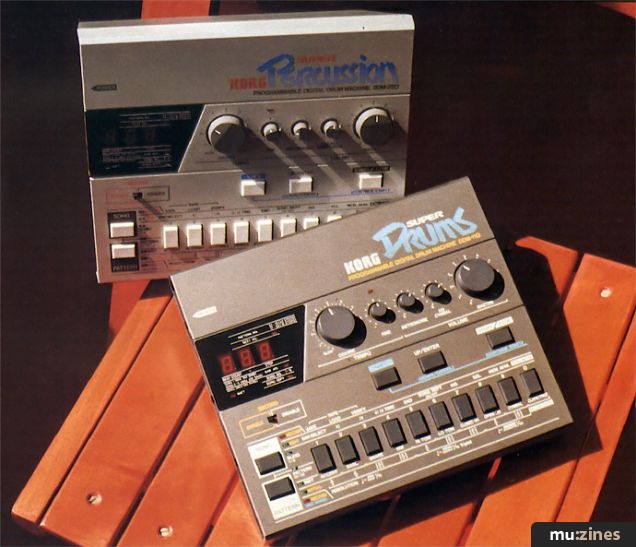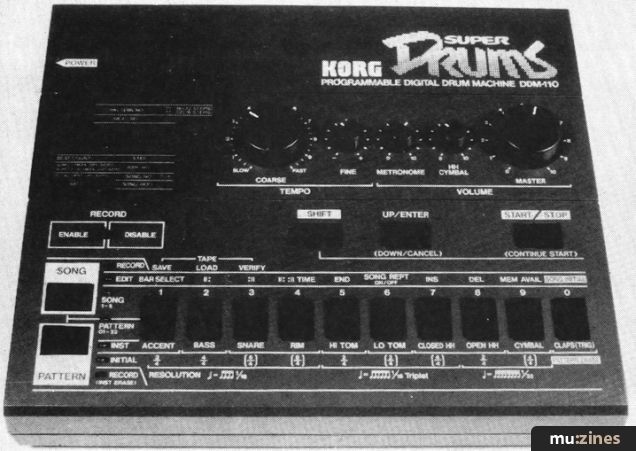Magazine Archive
Home -> Magazines -> Issues -> Articles in this issue -> View
Beat Box | |
Korg MR-16 MIDI Rhythm Sound UnitArticle from Electronic Soundmaker & Computer Music, September 1985 | |
Korg’s MIDI percussion module

MR-16 — a novel way into electronic percussion
Since the advent of MIDI, several new hybrid instruments have sprung up, one of which is Korg's MR16, which owes its very existence to that little four-letter word. This loosely labelled 'MIDI Rhythm Sound Unit' essentially consists of a box in which are stored 19 digitally sampled drum voices. These voices can only be extracted via the unit's MIDI bus — and either a MIDI instrument or sequencer.
The MR16's front facia consists of two rows of little knobs (two for each voice — volume and pan), and a single large knob which controls the master output volume and power on/off. The rest of the front panel's surface area is taken up with an illustration of 2½ octaves of keyboard, indicating which keys on a MIDI keyboard relate to which percussion voices.
The 19 percussion voices consist of the usual bass drum, snare, two toms, open and closed hi hats, rim shot, handclap, cowbell, crash and ride cymbals; as well as more colourful percussion instruments such as timbales, two agogos, two congas, woodblock, cabasa and tambourine. Some of the more 'vital' voices, such as bass drum, snare, closed hi hat, and toms, are assigned to two or more notes on the keyboard and this is a big help for when you are playing fast rolls in real time. One other sound that the MR16 produces is a metronome 'click'. Although the MR16 doesn't have a metronome itself, it will click along to MIDI clock information that it receives into its MIDI port — very clever...
The MR16 could be used in many different configurations, however its primary use is in conjunction with a MIDI sequencer and keyboard. In such a configuration, it could be programmed from a MIDI keyboard 'into' the sequencer — first bass drum and snare pattern, hi hat etc. in step time, and then fills and flams could be programmed in real time, thus giving a less clinical feel to the drum patterns. In this way, very realistic drum sequences could be built up, especially as the MR16 is somewhat touch sensitive (note my use of the word 'somewhat' as opposed to 'very', as it gives moderate volume change). Both features are fairly unique in a drum unit of this price.

The rear of the MR16 showing presets
On the MR16's rear panel is a group of presets which can be user-switched to enable/disable the metronome feature, as well as to select the unit's MIDI receive channel (via an over-complex binary matrix switching system). Additionally on the rear panel you will find individual audio outputs for each drum voice (a few voices share these outputs — cowbell and woodblock for example). Other rear panel connections are the MIDI In and Thru busses, an unwelcome 9V power supply socket, and master stereo outputs.
The sounds themselves are not bad, being derived from Korgs two 'stand-alone' sampled units, the Super Drums & Super Percussion. Timbales, agogos and congas in particular are very good, full of the character of their respective instruments. However, the bass drum, snare and toms leave more than a little to be desired, although careful EQing helps. The ride, crash and hi hats are better, with the crash taking a decent amount of time to decay.
SUMMING UP
At the moment, the MR16 is in a class of its own — and likely to remain so, I would have thought. In theory the notion of a box that lets your existing computer/MIDI sequencer to take care of all that programming business, leaving the 16 just with the task of bunging out the beats seems great. But that theory depends on two things — an attractive price (which the MR16 hasn't got when compared to the relatively low combined cost of its parents, the DDM110 and 220); and some good, dedicated software. Your sequencing packages and MSQ's can handle the job — but there's no substitute for specialisation.
To be fair the MR16 does offer some intriguing possibilities (doubling up MIDI drum kit voices, for example) and the ability to generate very 'human' drum patterns. Some software will probably become available sooner or later. But surely it wouldn't have cost very much more to have included some internal sequencing facility. This would have greatly extended the products' viability. As it stands, I can't see many people falling over themselves to buy it, sans software. Half a great idea.
Korg: (Contact Details)
Also featuring gear in this article
Korg MR16 - MIDI Percussion Voice Generator
(EMM May 85)
Korg MR16 Rhythm Sound Unit - Rhythmcheck
(IM Sep 85)
Browse category: Drum Module > Korg
Featuring related gear
In Triplet Time - Korg Drums
(ES Jan 85)
Korg DDM drum machines
(12T Oct 84)
Korg DDM110 - Programmable Drum Machine
(EMM Dec 84)
Korg DDM220 - Programmable Percussion Machine
(EMM Oct 84)
Browse category: Drum Machine > Korg
Publisher: Electronic Soundmaker & Computer Music - Cover Publications Ltd, Northern & Shell Ltd.
The current copyright owner/s of this content may differ from the originally published copyright notice.
More details on copyright ownership...
Review by Curtis Schwartz
Help Support The Things You Love
mu:zines is the result of thousands of hours of effort, and will require many thousands more going forward to reach our goals of getting all this content online.
If you value this resource, you can support this project - it really helps!
Donations for October 2025
Issues donated this month: 0
New issues that have been donated or scanned for us this month.
Funds donated this month: £0.00
All donations and support are gratefully appreciated - thank you.
Magazines Needed - Can You Help?
Do you have any of these magazine issues?
If so, and you can donate, lend or scan them to help complete our archive, please get in touch via the Contribute page - thanks!








